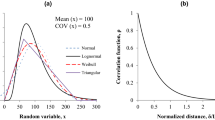Abstract
The random finite element method is used to investigate the effect of including a lower-bound shear strength on the reliability of undrained slopes. The lower bound is represented by the remolded undrained shear strength, which is determined using information about the sensitivity of the clay. This lower-bound strength is used to truncate the left-hand tail of the undrained strength probability distribution. Results indicate that for clayey slopes, the probability of failure is reduced when the lower-bound strength is incorporated in the random field. This reduction allows for reducing the design factor of safety while maintaining the same risk level in the slope design.














Similar content being viewed by others
References
Babu GLS, Mukesh MD (2004) Effect of soil variability on reliability of soil slopes. Geotechnique 54(5):325–337
Chow SE (2007) Effects of spatial variability of soil properties on slope stability. Eng Geol 923(4):97–109
Christian JT, Ladd CC, Baecher GB (1994) Reliability applied to slope stability analysis. J Geotech Eng 120(12):2180–2207
El-Ramly H, Morgenstern NR, Cruden DM (2002) Probabilistic slope stability analysis for practice. Can Geotech J 39:665–683
Fenton GA, Hicks MA, Wang X, Griffiths DV (2013) Effect of slope height and gradient on failure probability. Geotech Spec Publ(GSP 231):972–981
Gilbert RB, Najjar SS, Shields MK (2005) Importance of residual strengths in factors of safety and reliability. In: Proceedings Geo-Frontiers 2005. 18th GRI conference on geosynthetics research and development in progress. ASCE. Reston, Virginia
Griffiths DV, Fenton GA (2000) Influence of soil strength spatial variability on the stability of an undrained clay slope by finite element. In: Slope stability, pp 184–193
Griffiths DV, Fenton GA (2004) Probabilistic slope stability analysis by finite elements. J Geotech Geoenviron Eng 130(5):507–518
Griffiths DV, Fenton GA (2008) Risk assessment in geotechnical engineering. Wiley, New York
Griffiths DV, Marquez RM (2007) Three-dimensional slope stability analysis by elasto-plastic finite elements. Géotechnique 57:537–546
Griffiths DV, Yu X (2015) Another look at the stability of slopes with linearly increasing undrained strength. Geotechnique 65(10):824–830
Griffiths DV, Fenton GA, Denavit MD (2007) Traditional and advanced probabilistic slope stability analysis. In: Phoon KK, Fenton GA, Glynn EF, Juang CH, Griffiths DV, Wolff TF, Zhang L (eds) Proceedings of the GeoDenver Symposium. ASCE, Reston, pp 1–10
Griffiths DV, Huang J, Fenton GA (2009) Influence of spatial variability on slope reliability using 2-D random fields. J Geotech Geoenviron Eng 135(10):1367–1378
Huang J, Lyamin AV, Griffiths DV, Krabbenhoft K, Sloan SW (2013) Quantitative risk assessment of landslide by limit analysis and random fields. Comput Geotech 53:60–67
Jha S, Ching J (2013) Simplified reliability method for spatially variable undrained engineered slopes. Soils Found 53(5):708–719
Kahiel A, Najjar SS, Sadek S (2017a) Reliability-based design of spread footings on clays reinforced with aggregate piers. Georisk J 11(1):75–89
Kahiel A, Najjar SS, Sadek S (2017b) Incorporating model uncertainty and spatial variability in the design of footings on clays reinforced with stone columns. In: Proceedings of the GeoRisk Conference, June 6–8, Boulder, Colorado
Li KS, Lumb P (1987) Probabilistic design of slopes. Can Geotech J 24:520–531
Low BK (2003) Practical probabilistic slope stability analysis. In: Proceedings of the soil and rock America 2003 12th Panamerican conference on soil mechanics and geotechnical engineering, and 39th U.S. Rock Mechanics Symposium MIT, Cambridge, vol 2. Verlag Glückauf GmbH, Essen, pp 2777–2784
Malkawi AI, Hassan WF, Abdulla FA (2000) Uncertainty and reliability analysis applied to slope stability. Struct Saf 22:161–187
Najjar SS, Gilbert RB (2009) Importance of lower-bound capacities in the design of deep foundations. J Geotech Geoenviron Eng ASCE 135(7):890–900
Phoon KK, Kulhawy FH (1999) Characterization of geotechnical variability. Can Geotech J 36:612–624
Reddy SC, Stuedlein AW (2017a) Ultimate limit state reliability-based design of augered cast-in-place piles considering lower-bound capacities. Can Geotech J 54(12):1693–1703
Reddy SC, Stuedlein AW (2017b) Impact of resistance distribution selection on foundation reliability in consideration of lower-bound limits. In: Geo-Risk 2017: Reliability-Based Design and Code Developments. GSP 283:445–458
Stuedlein AW (2017) Role of lower bound capacity and shear strength anisotropy on probabilistic bearing capacity of plastic fine-grained soils. Geotech Spec Publ Honoring Wilson Tang GSP 286:203–213
Valle CM, Lopez J, Najjar SS, Gonzales FL (2012) Reliability analysis of clay-embedded offshore pipelines under vertical buckling considering lower-bound soil-pipe capacity. In: Proceedings of the 31st international conference on offshore mechanics and Arctic engineering—OMAE, 4, June 12–15, Rio De Janeiro, Brazil, pp 181–186
Valle CM, Lopez JA, Moreno JS, Najjar SS, Lopez NP (2014) Reliability functions for buried submarine pipelines in clay subjected to upheaval buckling. J Appl Ocean Res 40:308–321
Vanmarcke EH (1977) Reliability of earth slopes. J Geotech Eng Div 10311:1247–1265
Yang GA, Huang J, Griffiths DV, Sheng D (2017) Probabilistic stability analysis of slopes by conditional random fields. Geotech Spec Publ (GSP 282):69–97
Zue D, Griffiths DV, Fenton GA, Zhang L (2015) Undrained failure mechanisms of slopes in random soil. Eng Geol 191:31–35
Zue D, Griffiths DV, Huang J, Fenton GA (2017) Probabilistic stability analyses of undrained slopes with linearly increasing mean strength. Geotechnique 67(8):733–746
Acknowledgements
The authors would like to acknowledge Professors Griffiths and Fenton for granting them (and all interested parties) access to their valuable Software that includes the formulation of the RFEM. Without this access to the software, the authors would not have ventured into the topic addressed in this paper. The authors also acknowledge the support of the University Research Board (URB) at the American University of Beirut for funding this work.
Author information
Authors and Affiliations
Corresponding author
Additional information
Publisher's Note
Springer Nature remains neutral with regard to jurisdictional claims in published maps and institutional affiliations.
Rights and permissions
About this article
Cite this article
Najjar, S.S., Sadek, S. & Farah, Z. Importance of Lower-Bound Shear Strengths in the Reliability of Spatially Random Clayey Slopes. Geotech Geol Eng 38, 6623–6639 (2020). https://doi.org/10.1007/s10706-020-01459-3
Received:
Accepted:
Published:
Issue Date:
DOI: https://doi.org/10.1007/s10706-020-01459-3




